FNSTPB505 Property Law Assignment: Application of Legal Principles
VerifiedAdded on 2023/04/20
|22
|7723
|172
Homework Assignment
AI Summary
This assignment solution delves into the application of legal principles within property law, specifically addressing FNSTPB505. It covers the framework of the Australian legal system, interests in real property, shared and transferred interests, and personal and intellectual property. The solution explores various business-based scenarios to illustrate the ownership aspects of different types of property, including real, trust, personal, and intellectual. Furthermore, it examines the importance of risk management in business situations, providing a comprehensive overview of property law principles and their practical application within the Australian legal context. Access more solved assignments and past papers on Desklib.
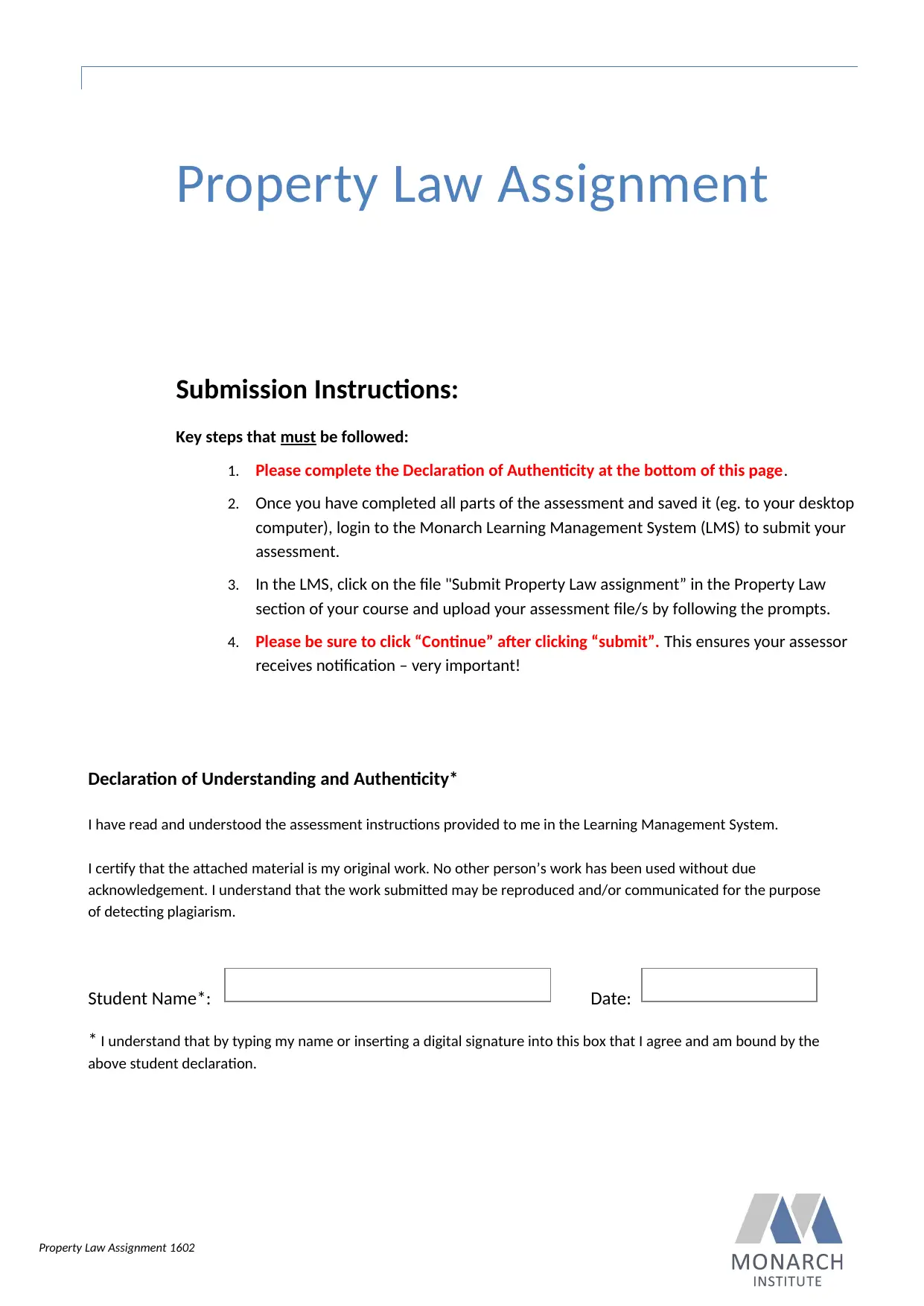
Property Law Assignment 1602
Property Law Assignment
Submission Instructions:
Key steps that must be followed:
1. Please complete the Declaration of Authenticity at the bottom of this page.
2. Once you have completed all parts of the assessment and saved it (eg. to your desktop
computer), login to the Monarch Learning Management System (LMS) to submit your
assessment.
3. In the LMS, click on the file "Submit Property Law assignment” in the Property Law
section of your course and upload your assessment file/s by following the prompts.
4. Please be sure to click “Continue” after clicking “submit”. This ensures your assessor
receives notification – very important!
Declaration of Understanding and Authenticity*
I have read and understood the assessment instructions provided to me in the Learning Management System.
I certify that the attached material is my original work. No other person’s work has been used without due
acknowledgement. I understand that the work submitted may be reproduced and/or communicated for the purpose
of detecting plagiarism.
Student Name*: Date:
* I understand that by typing my name or inserting a digital signature into this box that I agree and am bound by the
above student declaration.
Property Law Assignment
Submission Instructions:
Key steps that must be followed:
1. Please complete the Declaration of Authenticity at the bottom of this page.
2. Once you have completed all parts of the assessment and saved it (eg. to your desktop
computer), login to the Monarch Learning Management System (LMS) to submit your
assessment.
3. In the LMS, click on the file "Submit Property Law assignment” in the Property Law
section of your course and upload your assessment file/s by following the prompts.
4. Please be sure to click “Continue” after clicking “submit”. This ensures your assessor
receives notification – very important!
Declaration of Understanding and Authenticity*
I have read and understood the assessment instructions provided to me in the Learning Management System.
I certify that the attached material is my original work. No other person’s work has been used without due
acknowledgement. I understand that the work submitted may be reproduced and/or communicated for the purpose
of detecting plagiarism.
Student Name*: Date:
* I understand that by typing my name or inserting a digital signature into this box that I agree and am bound by the
above student declaration.
Paraphrase This Document
Need a fresh take? Get an instant paraphrase of this document with our AI Paraphraser

Property Law Assignment 1602
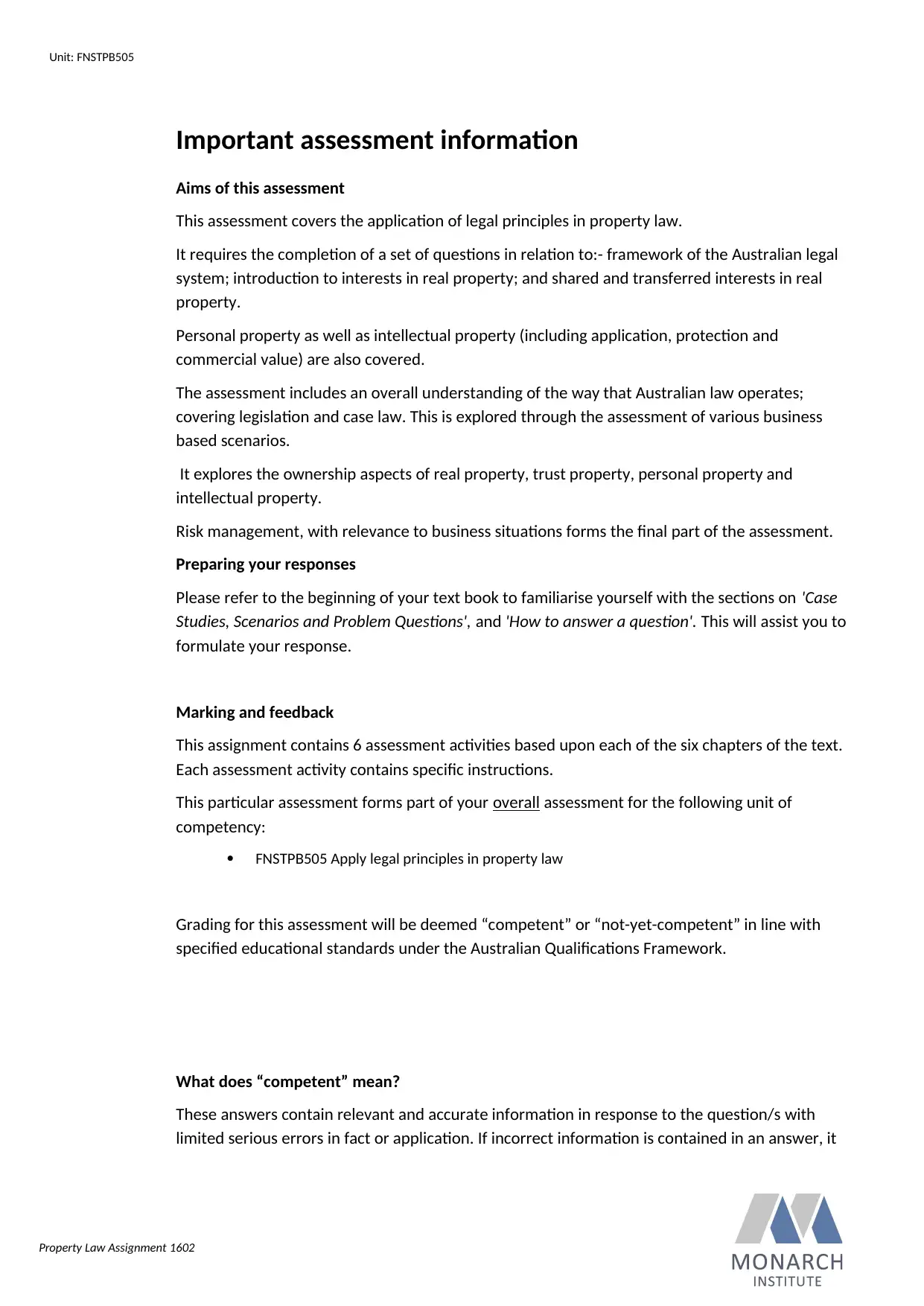
Property Law Assignment 1602
Important assessment information
Aims of this assessment
This assessment covers the application of legal principles in property law.
It requires the completion of a set of questions in relation to:- framework of the Australian legal
system; introduction to interests in real property; and shared and transferred interests in real
property.
Personal property as well as intellectual property (including application, protection and
commercial value) are also covered.
The assessment includes an overall understanding of the way that Australian law operates;
covering legislation and case law. This is explored through the assessment of various business
based scenarios.
It explores the ownership aspects of real property, trust property, personal property and
intellectual property.
Risk management, with relevance to business situations forms the final part of the assessment.
Preparing your responses
Please refer to the beginning of your text book to familiarise yourself with the sections on 'Case
Studies, Scenarios and Problem Questions', and 'How to answer a question'. This will assist you to
formulate your response.
Marking and feedback
This assignment contains 6 assessment activities based upon each of the six chapters of the text.
Each assessment activity contains specific instructions.
This particular assessment forms part of your overall assessment for the following unit of
competency:
FNSTPB505 Apply legal principles in property law
Grading for this assessment will be deemed “competent” or “not-yet-competent” in line with
specified educational standards under the Australian Qualifications Framework.
What does “competent” mean?
These answers contain relevant and accurate information in response to the question/s with
limited serious errors in fact or application. If incorrect information is contained in an answer, it
Unit: FNSTPB505
Important assessment information
Aims of this assessment
This assessment covers the application of legal principles in property law.
It requires the completion of a set of questions in relation to:- framework of the Australian legal
system; introduction to interests in real property; and shared and transferred interests in real
property.
Personal property as well as intellectual property (including application, protection and
commercial value) are also covered.
The assessment includes an overall understanding of the way that Australian law operates;
covering legislation and case law. This is explored through the assessment of various business
based scenarios.
It explores the ownership aspects of real property, trust property, personal property and
intellectual property.
Risk management, with relevance to business situations forms the final part of the assessment.
Preparing your responses
Please refer to the beginning of your text book to familiarise yourself with the sections on 'Case
Studies, Scenarios and Problem Questions', and 'How to answer a question'. This will assist you to
formulate your response.
Marking and feedback
This assignment contains 6 assessment activities based upon each of the six chapters of the text.
Each assessment activity contains specific instructions.
This particular assessment forms part of your overall assessment for the following unit of
competency:
FNSTPB505 Apply legal principles in property law
Grading for this assessment will be deemed “competent” or “not-yet-competent” in line with
specified educational standards under the Australian Qualifications Framework.
What does “competent” mean?
These answers contain relevant and accurate information in response to the question/s with
limited serious errors in fact or application. If incorrect information is contained in an answer, it
Unit: FNSTPB505
⊘ This is a preview!⊘
Do you want full access?
Subscribe today to unlock all pages.

Trusted by 1+ million students worldwide
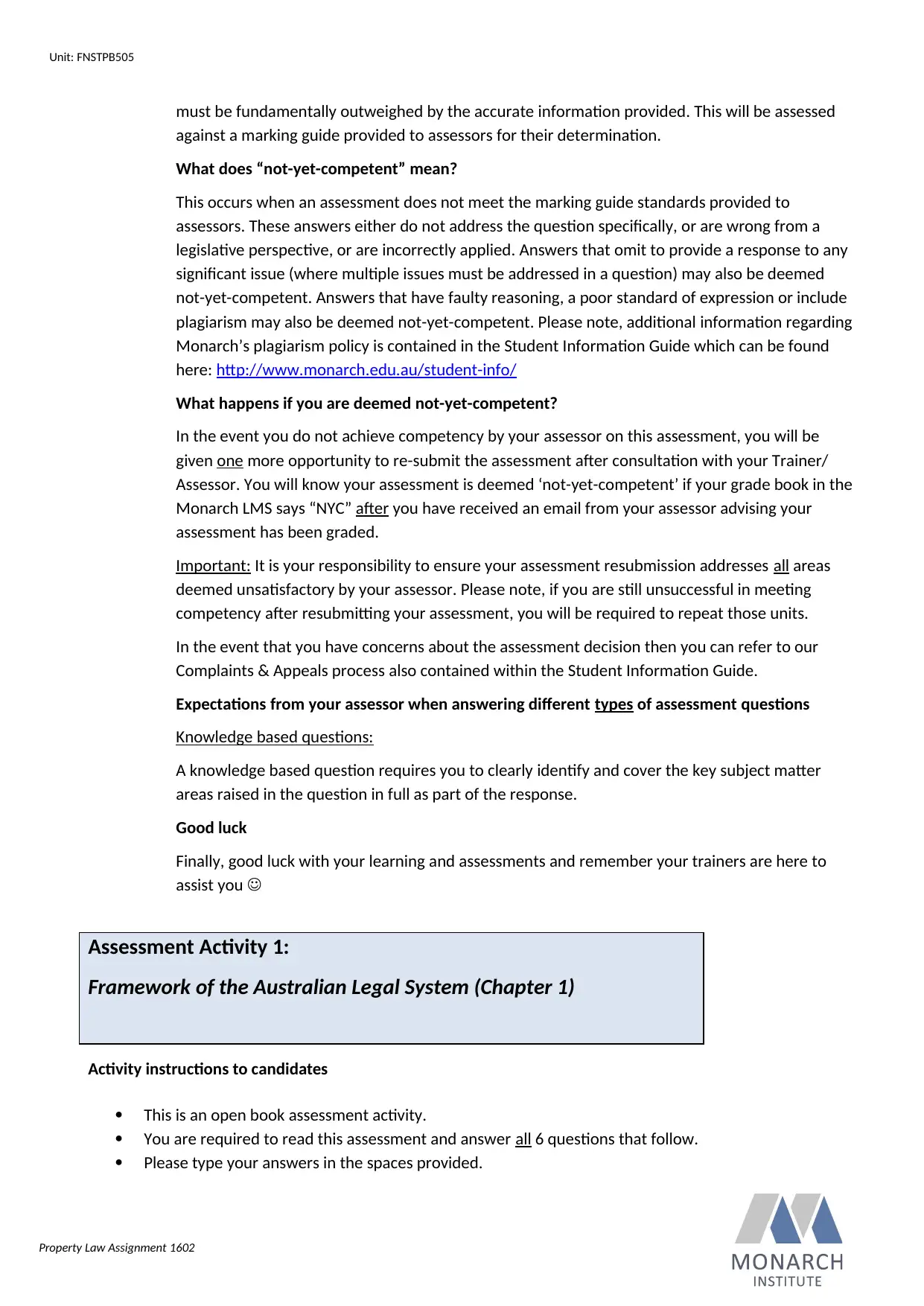
Property Law Assignment 1602
must be fundamentally outweighed by the accurate information provided. This will be assessed
against a marking guide provided to assessors for their determination.
What does “not-yet-competent” mean?
This occurs when an assessment does not meet the marking guide standards provided to
assessors. These answers either do not address the question specifically, or are wrong from a
legislative perspective, or are incorrectly applied. Answers that omit to provide a response to any
significant issue (where multiple issues must be addressed in a question) may also be deemed
not-yet-competent. Answers that have faulty reasoning, a poor standard of expression or include
plagiarism may also be deemed not-yet-competent. Please note, additional information regarding
Monarch’s plagiarism policy is contained in the Student Information Guide which can be found
here: http://www.monarch.edu.au/student-info/
What happens if you are deemed not-yet-competent?
In the event you do not achieve competency by your assessor on this assessment, you will be
given one more opportunity to re-submit the assessment after consultation with your Trainer/
Assessor. You will know your assessment is deemed ‘not-yet-competent’ if your grade book in the
Monarch LMS says “NYC” after you have received an email from your assessor advising your
assessment has been graded.
Important: It is your responsibility to ensure your assessment resubmission addresses all areas
deemed unsatisfactory by your assessor. Please note, if you are still unsuccessful in meeting
competency after resubmitting your assessment, you will be required to repeat those units.
In the event that you have concerns about the assessment decision then you can refer to our
Complaints & Appeals process also contained within the Student Information Guide.
Expectations from your assessor when answering different types of assessment questions
Knowledge based questions:
A knowledge based question requires you to clearly identify and cover the key subject matter
areas raised in the question in full as part of the response.
Good luck
Finally, good luck with your learning and assessments and remember your trainers are here to
assist you
Activity instructions to candidates
This is an open book assessment activity.
You are required to read this assessment and answer all 6 questions that follow.
Please type your answers in the spaces provided.
Assessment Activity 1:
Framework of the Australian Legal System (Chapter 1)
Unit: FNSTPB505
must be fundamentally outweighed by the accurate information provided. This will be assessed
against a marking guide provided to assessors for their determination.
What does “not-yet-competent” mean?
This occurs when an assessment does not meet the marking guide standards provided to
assessors. These answers either do not address the question specifically, or are wrong from a
legislative perspective, or are incorrectly applied. Answers that omit to provide a response to any
significant issue (where multiple issues must be addressed in a question) may also be deemed
not-yet-competent. Answers that have faulty reasoning, a poor standard of expression or include
plagiarism may also be deemed not-yet-competent. Please note, additional information regarding
Monarch’s plagiarism policy is contained in the Student Information Guide which can be found
here: http://www.monarch.edu.au/student-info/
What happens if you are deemed not-yet-competent?
In the event you do not achieve competency by your assessor on this assessment, you will be
given one more opportunity to re-submit the assessment after consultation with your Trainer/
Assessor. You will know your assessment is deemed ‘not-yet-competent’ if your grade book in the
Monarch LMS says “NYC” after you have received an email from your assessor advising your
assessment has been graded.
Important: It is your responsibility to ensure your assessment resubmission addresses all areas
deemed unsatisfactory by your assessor. Please note, if you are still unsuccessful in meeting
competency after resubmitting your assessment, you will be required to repeat those units.
In the event that you have concerns about the assessment decision then you can refer to our
Complaints & Appeals process also contained within the Student Information Guide.
Expectations from your assessor when answering different types of assessment questions
Knowledge based questions:
A knowledge based question requires you to clearly identify and cover the key subject matter
areas raised in the question in full as part of the response.
Good luck
Finally, good luck with your learning and assessments and remember your trainers are here to
assist you
Activity instructions to candidates
This is an open book assessment activity.
You are required to read this assessment and answer all 6 questions that follow.
Please type your answers in the spaces provided.
Assessment Activity 1:
Framework of the Australian Legal System (Chapter 1)
Unit: FNSTPB505
Paraphrase This Document
Need a fresh take? Get an instant paraphrase of this document with our AI Paraphraser
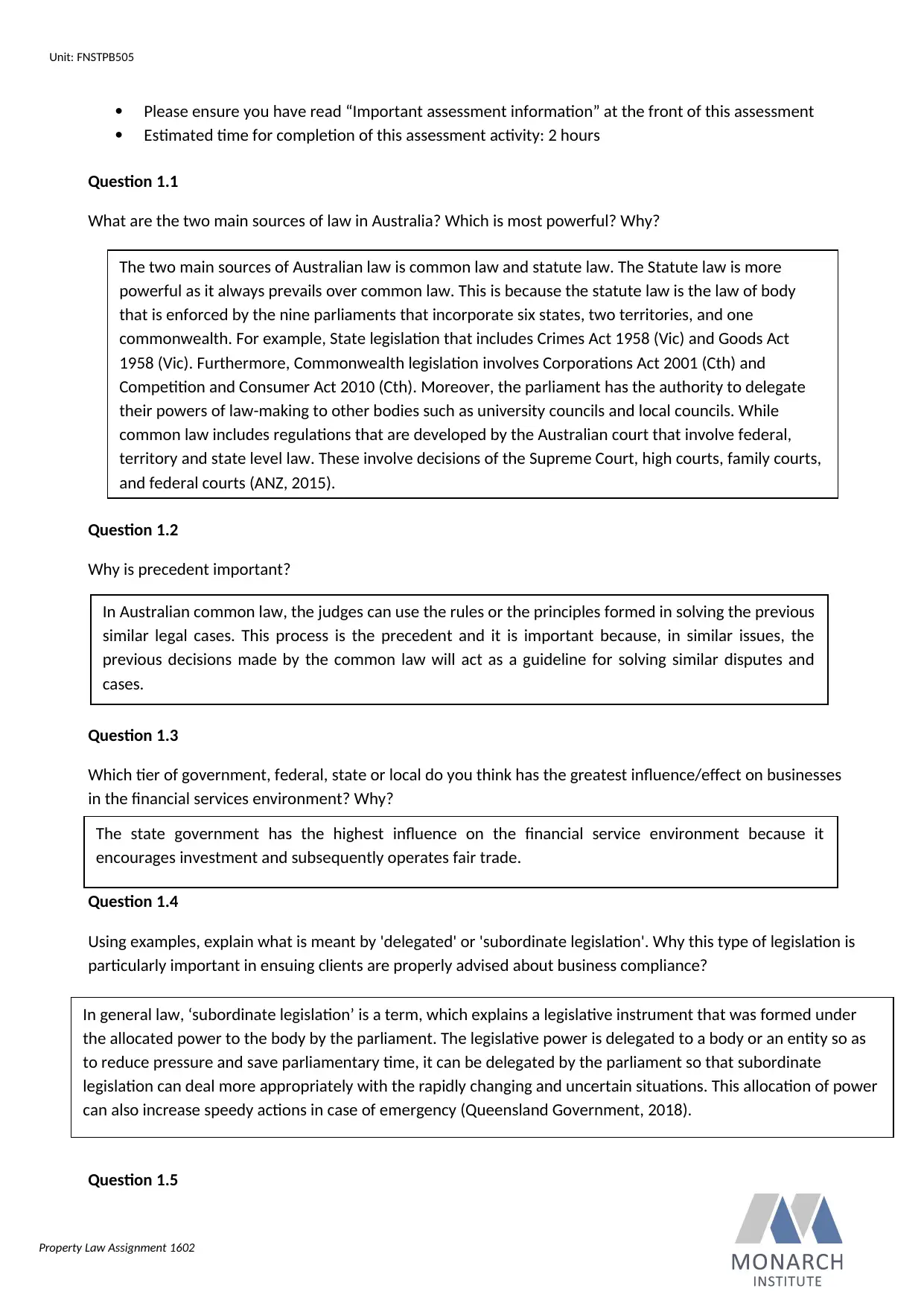
Property Law Assignment 1602
Please ensure you have read “Important assessment information” at the front of this assessment
Estimated time for completion of this assessment activity: 2 hours
Question 1.1
What are the two main sources of law in Australia? Which is most powerful? Why?
Question 1.2
Why is precedent important?
Question 1.3
Which tier of government, federal, state or local do you think has the greatest influence/effect on businesses
in the financial services environment? Why?
Question 1.4
Using examples, explain what is meant by 'delegated' or 'subordinate legislation'. Why this type of legislation is
particularly important in ensuing clients are properly advised about business compliance?
Question 1.5
Unit: FNSTPB505
The two main sources of Australian law is common law and statute law. The Statute law is more
powerful as it always prevails over common law. This is because the statute law is the law of body
that is enforced by the nine parliaments that incorporate six states, two territories, and one
commonwealth. For example, State legislation that includes Crimes Act 1958 (Vic) and Goods Act
1958 (Vic). Furthermore, Commonwealth legislation involves Corporations Act 2001 (Cth) and
Competition and Consumer Act 2010 (Cth). Moreover, the parliament has the authority to delegate
their powers of law-making to other bodies such as university councils and local councils. While
common law includes regulations that are developed by the Australian court that involve federal,
territory and state level law. These involve decisions of the Supreme Court, high courts, family courts,
and federal courts (ANZ, 2015).
In Australian common law, the judges can use the rules or the principles formed in solving the previous
similar legal cases. This process is the precedent and it is important because, in similar issues, the
previous decisions made by the common law will act as a guideline for solving similar disputes and
cases.
The state government has the highest influence on the financial service environment because it
encourages investment and subsequently operates fair trade.
In general law, ‘subordinate legislation’ is a term, which explains a legislative instrument that was formed under
the allocated power to the body by the parliament. The legislative power is delegated to a body or an entity so as
to reduce pressure and save parliamentary time, it can be delegated by the parliament so that subordinate
legislation can deal more appropriately with the rapidly changing and uncertain situations. This allocation of power
can also increase speedy actions in case of emergency (Queensland Government, 2018).
Please ensure you have read “Important assessment information” at the front of this assessment
Estimated time for completion of this assessment activity: 2 hours
Question 1.1
What are the two main sources of law in Australia? Which is most powerful? Why?
Question 1.2
Why is precedent important?
Question 1.3
Which tier of government, federal, state or local do you think has the greatest influence/effect on businesses
in the financial services environment? Why?
Question 1.4
Using examples, explain what is meant by 'delegated' or 'subordinate legislation'. Why this type of legislation is
particularly important in ensuing clients are properly advised about business compliance?
Question 1.5
Unit: FNSTPB505
The two main sources of Australian law is common law and statute law. The Statute law is more
powerful as it always prevails over common law. This is because the statute law is the law of body
that is enforced by the nine parliaments that incorporate six states, two territories, and one
commonwealth. For example, State legislation that includes Crimes Act 1958 (Vic) and Goods Act
1958 (Vic). Furthermore, Commonwealth legislation involves Corporations Act 2001 (Cth) and
Competition and Consumer Act 2010 (Cth). Moreover, the parliament has the authority to delegate
their powers of law-making to other bodies such as university councils and local councils. While
common law includes regulations that are developed by the Australian court that involve federal,
territory and state level law. These involve decisions of the Supreme Court, high courts, family courts,
and federal courts (ANZ, 2015).
In Australian common law, the judges can use the rules or the principles formed in solving the previous
similar legal cases. This process is the precedent and it is important because, in similar issues, the
previous decisions made by the common law will act as a guideline for solving similar disputes and
cases.
The state government has the highest influence on the financial service environment because it
encourages investment and subsequently operates fair trade.
In general law, ‘subordinate legislation’ is a term, which explains a legislative instrument that was formed under
the allocated power to the body by the parliament. The legislative power is delegated to a body or an entity so as
to reduce pressure and save parliamentary time, it can be delegated by the parliament so that subordinate
legislation can deal more appropriately with the rapidly changing and uncertain situations. This allocation of power
can also increase speedy actions in case of emergency (Queensland Government, 2018).
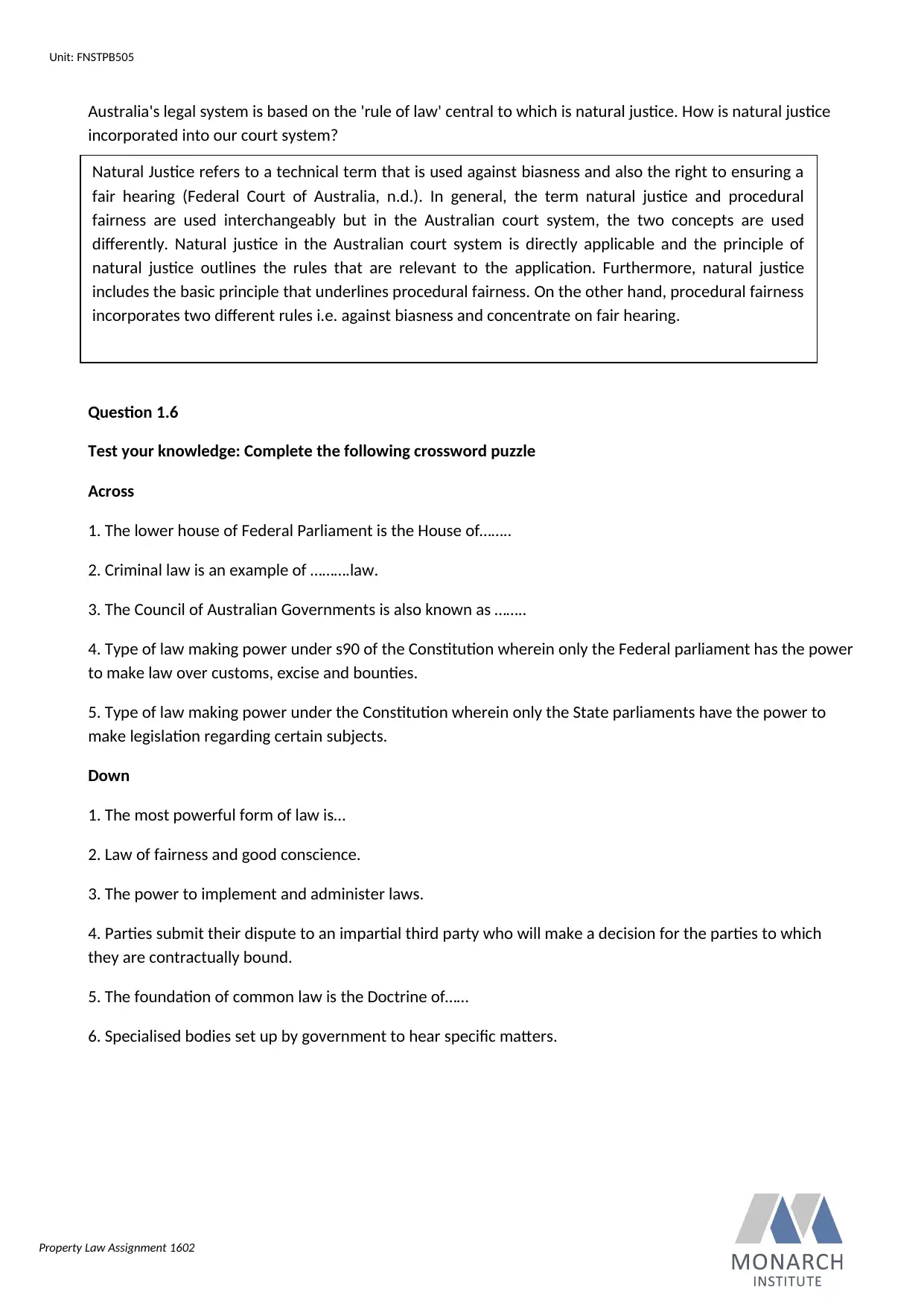
Property Law Assignment 1602
Australia's legal system is based on the 'rule of law' central to which is natural justice. How is natural justice
incorporated into our court system?
Question 1.6
Test your knowledge: Complete the following crossword puzzle
Across
1. The lower house of Federal Parliament is the House of……..
2. Criminal law is an example of ……….law.
3. The Council of Australian Governments is also known as ……..
4. Type of law making power under s90 of the Constitution wherein only the Federal parliament has the power
to make law over customs, excise and bounties.
5. Type of law making power under the Constitution wherein only the State parliaments have the power to
make legislation regarding certain subjects.
Down
1. The most powerful form of law is…
2. Law of fairness and good conscience.
3. The power to implement and administer laws.
4. Parties submit their dispute to an impartial third party who will make a decision for the parties to which
they are contractually bound.
5. The foundation of common law is the Doctrine of……
6. Specialised bodies set up by government to hear specific matters.
Unit: FNSTPB505
Natural Justice refers to a technical term that is used against biasness and also the right to ensuring a
fair hearing (Federal Court of Australia, n.d.). In general, the term natural justice and procedural
fairness are used interchangeably but in the Australian court system, the two concepts are used
differently. Natural justice in the Australian court system is directly applicable and the principle of
natural justice outlines the rules that are relevant to the application. Furthermore, natural justice
includes the basic principle that underlines procedural fairness. On the other hand, procedural fairness
incorporates two different rules i.e. against biasness and concentrate on fair hearing.
Australia's legal system is based on the 'rule of law' central to which is natural justice. How is natural justice
incorporated into our court system?
Question 1.6
Test your knowledge: Complete the following crossword puzzle
Across
1. The lower house of Federal Parliament is the House of……..
2. Criminal law is an example of ……….law.
3. The Council of Australian Governments is also known as ……..
4. Type of law making power under s90 of the Constitution wherein only the Federal parliament has the power
to make law over customs, excise and bounties.
5. Type of law making power under the Constitution wherein only the State parliaments have the power to
make legislation regarding certain subjects.
Down
1. The most powerful form of law is…
2. Law of fairness and good conscience.
3. The power to implement and administer laws.
4. Parties submit their dispute to an impartial third party who will make a decision for the parties to which
they are contractually bound.
5. The foundation of common law is the Doctrine of……
6. Specialised bodies set up by government to hear specific matters.
Unit: FNSTPB505
Natural Justice refers to a technical term that is used against biasness and also the right to ensuring a
fair hearing (Federal Court of Australia, n.d.). In general, the term natural justice and procedural
fairness are used interchangeably but in the Australian court system, the two concepts are used
differently. Natural justice in the Australian court system is directly applicable and the principle of
natural justice outlines the rules that are relevant to the application. Furthermore, natural justice
includes the basic principle that underlines procedural fairness. On the other hand, procedural fairness
incorporates two different rules i.e. against biasness and concentrate on fair hearing.
⊘ This is a preview!⊘
Do you want full access?
Subscribe today to unlock all pages.

Trusted by 1+ million students worldwide
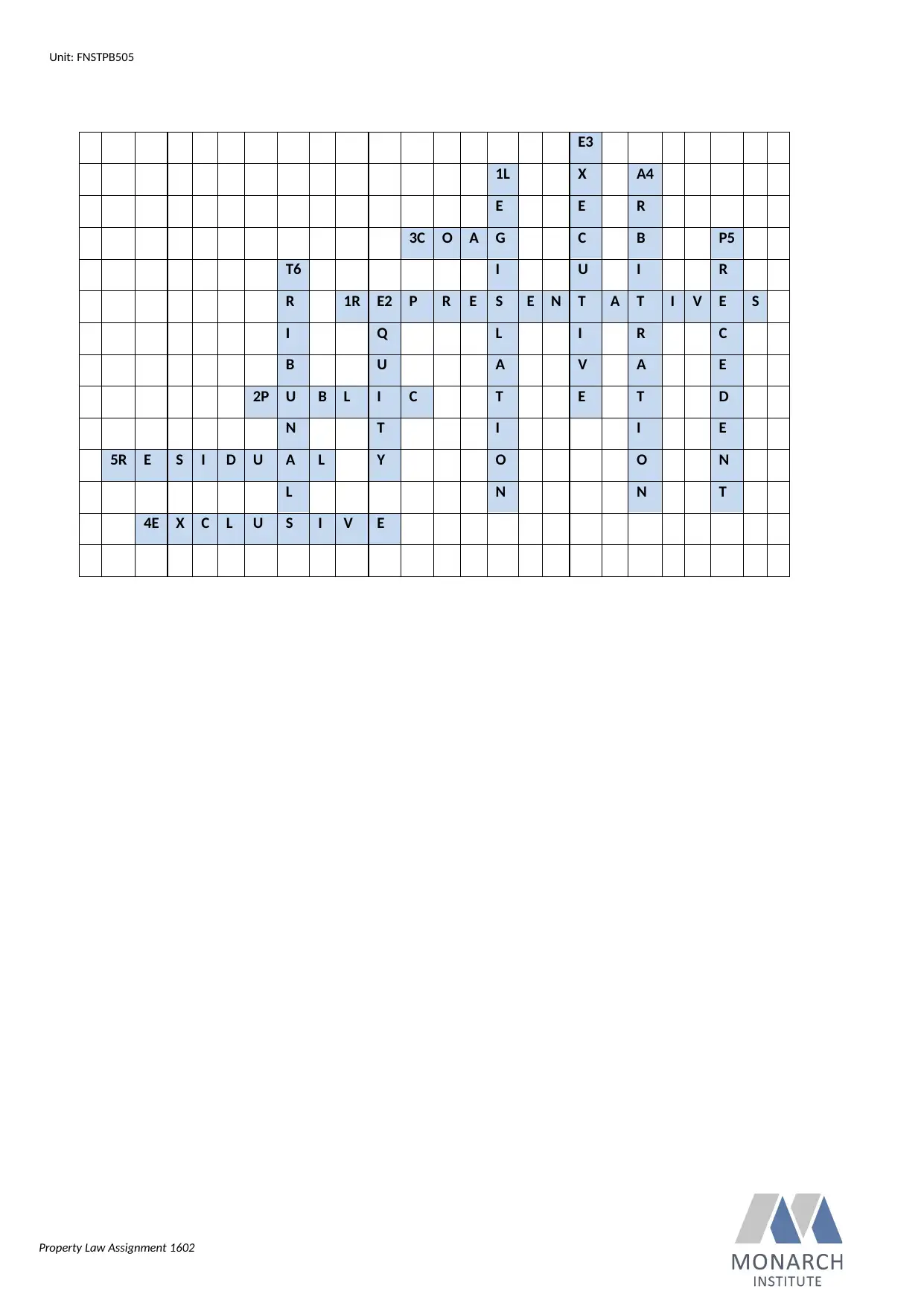
Property Law Assignment 1602
E3
1L X A4
E E R
3C O A G C B P5
T6 I U I R
R 1R E2 P R E S E N T A T I V E S
I Q L I R C
B U A V A E
2P U B L I C T E T D
N T I I E
5R E S I D U A L Y O O N
L N N T
4E X C L U S I V E
Unit: FNSTPB505
E3
1L X A4
E E R
3C O A G C B P5
T6 I U I R
R 1R E2 P R E S E N T A T I V E S
I Q L I R C
B U A V A E
2P U B L I C T E T D
N T I I E
5R E S I D U A L Y O O N
L N N T
4E X C L U S I V E
Unit: FNSTPB505
Paraphrase This Document
Need a fresh take? Get an instant paraphrase of this document with our AI Paraphraser
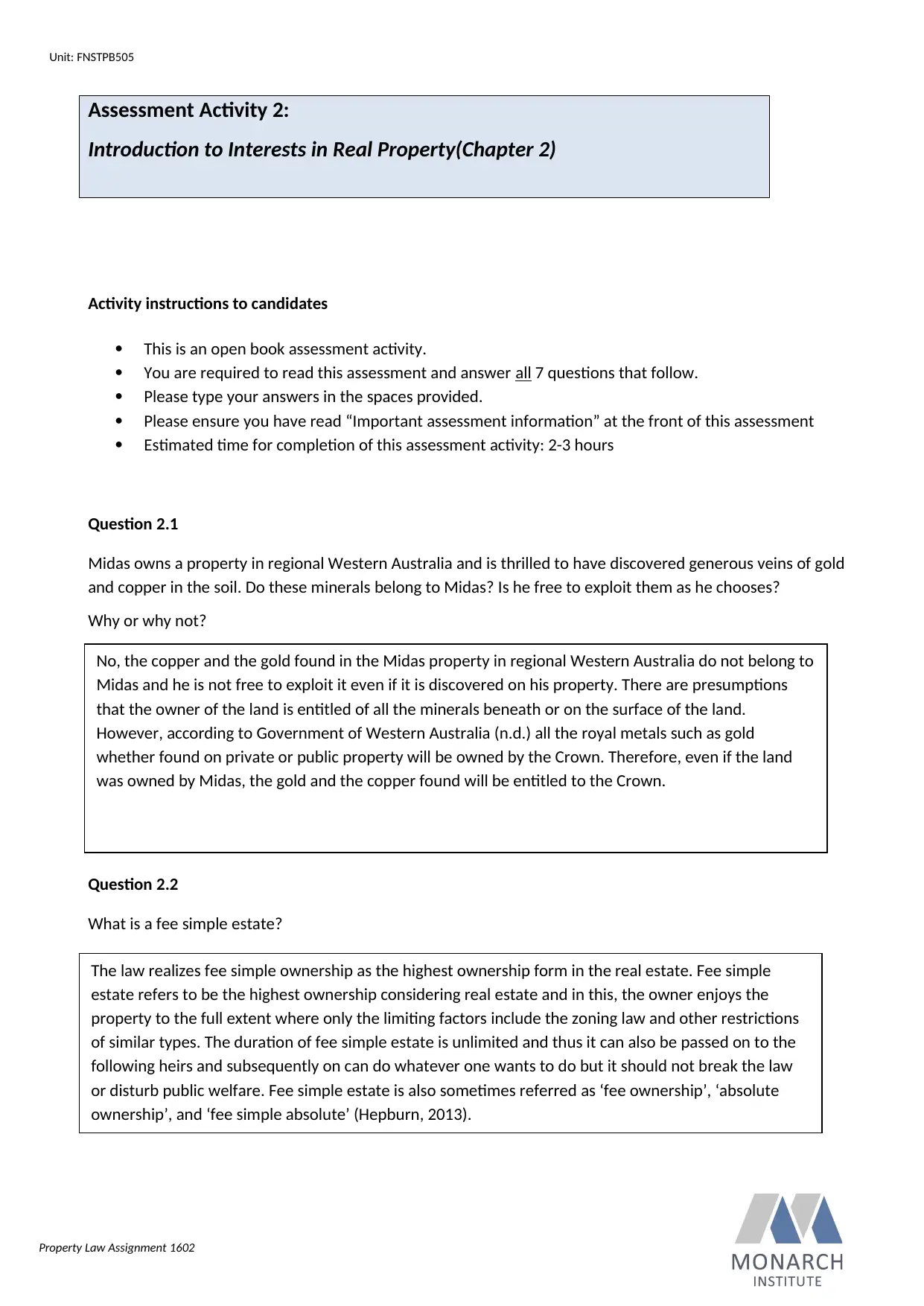
Property Law Assignment 1602
Activity instructions to candidates
This is an open book assessment activity.
You are required to read this assessment and answer all 7 questions that follow.
Please type your answers in the spaces provided.
Please ensure you have read “Important assessment information” at the front of this assessment
Estimated time for completion of this assessment activity: 2-3 hours
Question 2.1
Midas owns a property in regional Western Australia and is thrilled to have discovered generous veins of gold
and copper in the soil. Do these minerals belong to Midas? Is he free to exploit them as he chooses?
Why or why not?
Question 2.2
What is a fee simple estate?
Assessment Activity 2:
Introduction to Interests in Real Property(Chapter 2)
Unit: FNSTPB505
No, the copper and the gold found in the Midas property in regional Western Australia do not belong to
Midas and he is not free to exploit it even if it is discovered on his property. There are presumptions
that the owner of the land is entitled of all the minerals beneath or on the surface of the land.
However, according to Government of Western Australia (n.d.) all the royal metals such as gold
whether found on private or public property will be owned by the Crown. Therefore, even if the land
was owned by Midas, the gold and the copper found will be entitled to the Crown.
The law realizes fee simple ownership as the highest ownership form in the real estate. Fee simple
estate refers to be the highest ownership considering real estate and in this, the owner enjoys the
property to the full extent where only the limiting factors include the zoning law and other restrictions
of similar types. The duration of fee simple estate is unlimited and thus it can also be passed on to the
following heirs and subsequently on can do whatever one wants to do but it should not break the law
or disturb public welfare. Fee simple estate is also sometimes referred as ‘fee ownership’, ‘absolute
ownership’, and ‘fee simple absolute’ (Hepburn, 2013).
Activity instructions to candidates
This is an open book assessment activity.
You are required to read this assessment and answer all 7 questions that follow.
Please type your answers in the spaces provided.
Please ensure you have read “Important assessment information” at the front of this assessment
Estimated time for completion of this assessment activity: 2-3 hours
Question 2.1
Midas owns a property in regional Western Australia and is thrilled to have discovered generous veins of gold
and copper in the soil. Do these minerals belong to Midas? Is he free to exploit them as he chooses?
Why or why not?
Question 2.2
What is a fee simple estate?
Assessment Activity 2:
Introduction to Interests in Real Property(Chapter 2)
Unit: FNSTPB505
No, the copper and the gold found in the Midas property in regional Western Australia do not belong to
Midas and he is not free to exploit it even if it is discovered on his property. There are presumptions
that the owner of the land is entitled of all the minerals beneath or on the surface of the land.
However, according to Government of Western Australia (n.d.) all the royal metals such as gold
whether found on private or public property will be owned by the Crown. Therefore, even if the land
was owned by Midas, the gold and the copper found will be entitled to the Crown.
The law realizes fee simple ownership as the highest ownership form in the real estate. Fee simple
estate refers to be the highest ownership considering real estate and in this, the owner enjoys the
property to the full extent where only the limiting factors include the zoning law and other restrictions
of similar types. The duration of fee simple estate is unlimited and thus it can also be passed on to the
following heirs and subsequently on can do whatever one wants to do but it should not break the law
or disturb public welfare. Fee simple estate is also sometimes referred as ‘fee ownership’, ‘absolute
ownership’, and ‘fee simple absolute’ (Hepburn, 2013).
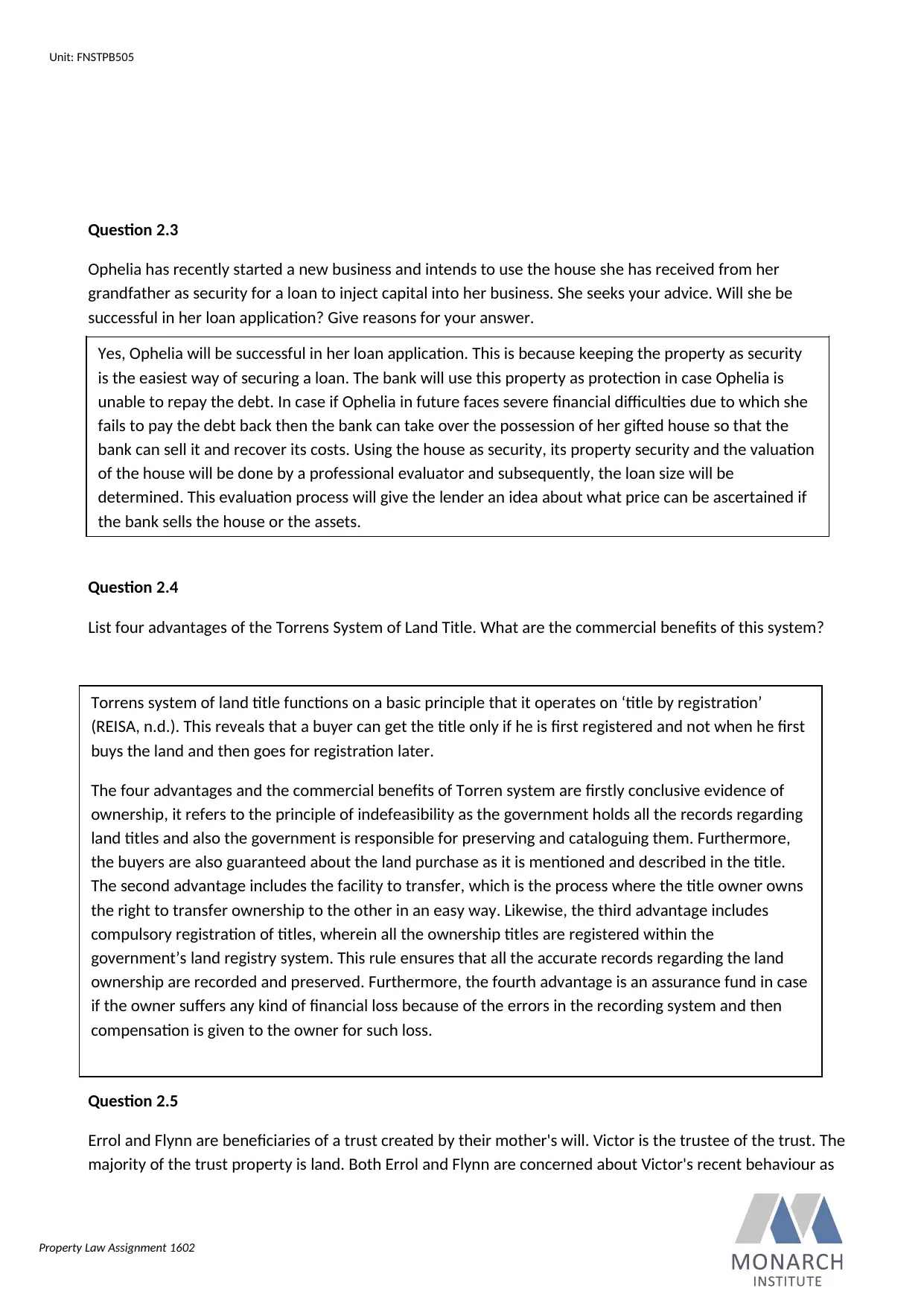
Property Law Assignment 1602
Question 2.3
Ophelia has recently started a new business and intends to use the house she has received from her
grandfather as security for a loan to inject capital into her business. She seeks your advice. Will she be
successful in her loan application? Give reasons for your answer.
Question 2.4
List four advantages of the Torrens System of Land Title. What are the commercial benefits of this system?
Question 2.5
Errol and Flynn are beneficiaries of a trust created by their mother's will. Victor is the trustee of the trust. The
majority of the trust property is land. Both Errol and Flynn are concerned about Victor's recent behaviour as
Unit: FNSTPB505
Yes, Ophelia will be successful in her loan application. This is because keeping the property as security
is the easiest way of securing a loan. The bank will use this property as protection in case Ophelia is
unable to repay the debt. In case if Ophelia in future faces severe financial difficulties due to which she
fails to pay the debt back then the bank can take over the possession of her gifted house so that the
bank can sell it and recover its costs. Using the house as security, its property security and the valuation
of the house will be done by a professional evaluator and subsequently, the loan size will be
determined. This evaluation process will give the lender an idea about what price can be ascertained if
the bank sells the house or the assets.
Torrens system of land title functions on a basic principle that it operates on ‘title by registration’
(REISA, n.d.). This reveals that a buyer can get the title only if he is first registered and not when he first
buys the land and then goes for registration later.
The four advantages and the commercial benefits of Torren system are firstly conclusive evidence of
ownership, it refers to the principle of indefeasibility as the government holds all the records regarding
land titles and also the government is responsible for preserving and cataloguing them. Furthermore,
the buyers are also guaranteed about the land purchase as it is mentioned and described in the title.
The second advantage includes the facility to transfer, which is the process where the title owner owns
the right to transfer ownership to the other in an easy way. Likewise, the third advantage includes
compulsory registration of titles, wherein all the ownership titles are registered within the
government’s land registry system. This rule ensures that all the accurate records regarding the land
ownership are recorded and preserved. Furthermore, the fourth advantage is an assurance fund in case
if the owner suffers any kind of financial loss because of the errors in the recording system and then
compensation is given to the owner for such loss.
Question 2.3
Ophelia has recently started a new business and intends to use the house she has received from her
grandfather as security for a loan to inject capital into her business. She seeks your advice. Will she be
successful in her loan application? Give reasons for your answer.
Question 2.4
List four advantages of the Torrens System of Land Title. What are the commercial benefits of this system?
Question 2.5
Errol and Flynn are beneficiaries of a trust created by their mother's will. Victor is the trustee of the trust. The
majority of the trust property is land. Both Errol and Flynn are concerned about Victor's recent behaviour as
Unit: FNSTPB505
Yes, Ophelia will be successful in her loan application. This is because keeping the property as security
is the easiest way of securing a loan. The bank will use this property as protection in case Ophelia is
unable to repay the debt. In case if Ophelia in future faces severe financial difficulties due to which she
fails to pay the debt back then the bank can take over the possession of her gifted house so that the
bank can sell it and recover its costs. Using the house as security, its property security and the valuation
of the house will be done by a professional evaluator and subsequently, the loan size will be
determined. This evaluation process will give the lender an idea about what price can be ascertained if
the bank sells the house or the assets.
Torrens system of land title functions on a basic principle that it operates on ‘title by registration’
(REISA, n.d.). This reveals that a buyer can get the title only if he is first registered and not when he first
buys the land and then goes for registration later.
The four advantages and the commercial benefits of Torren system are firstly conclusive evidence of
ownership, it refers to the principle of indefeasibility as the government holds all the records regarding
land titles and also the government is responsible for preserving and cataloguing them. Furthermore,
the buyers are also guaranteed about the land purchase as it is mentioned and described in the title.
The second advantage includes the facility to transfer, which is the process where the title owner owns
the right to transfer ownership to the other in an easy way. Likewise, the third advantage includes
compulsory registration of titles, wherein all the ownership titles are registered within the
government’s land registry system. This rule ensures that all the accurate records regarding the land
ownership are recorded and preserved. Furthermore, the fourth advantage is an assurance fund in case
if the owner suffers any kind of financial loss because of the errors in the recording system and then
compensation is given to the owner for such loss.
⊘ This is a preview!⊘
Do you want full access?
Subscribe today to unlock all pages.

Trusted by 1+ million students worldwide
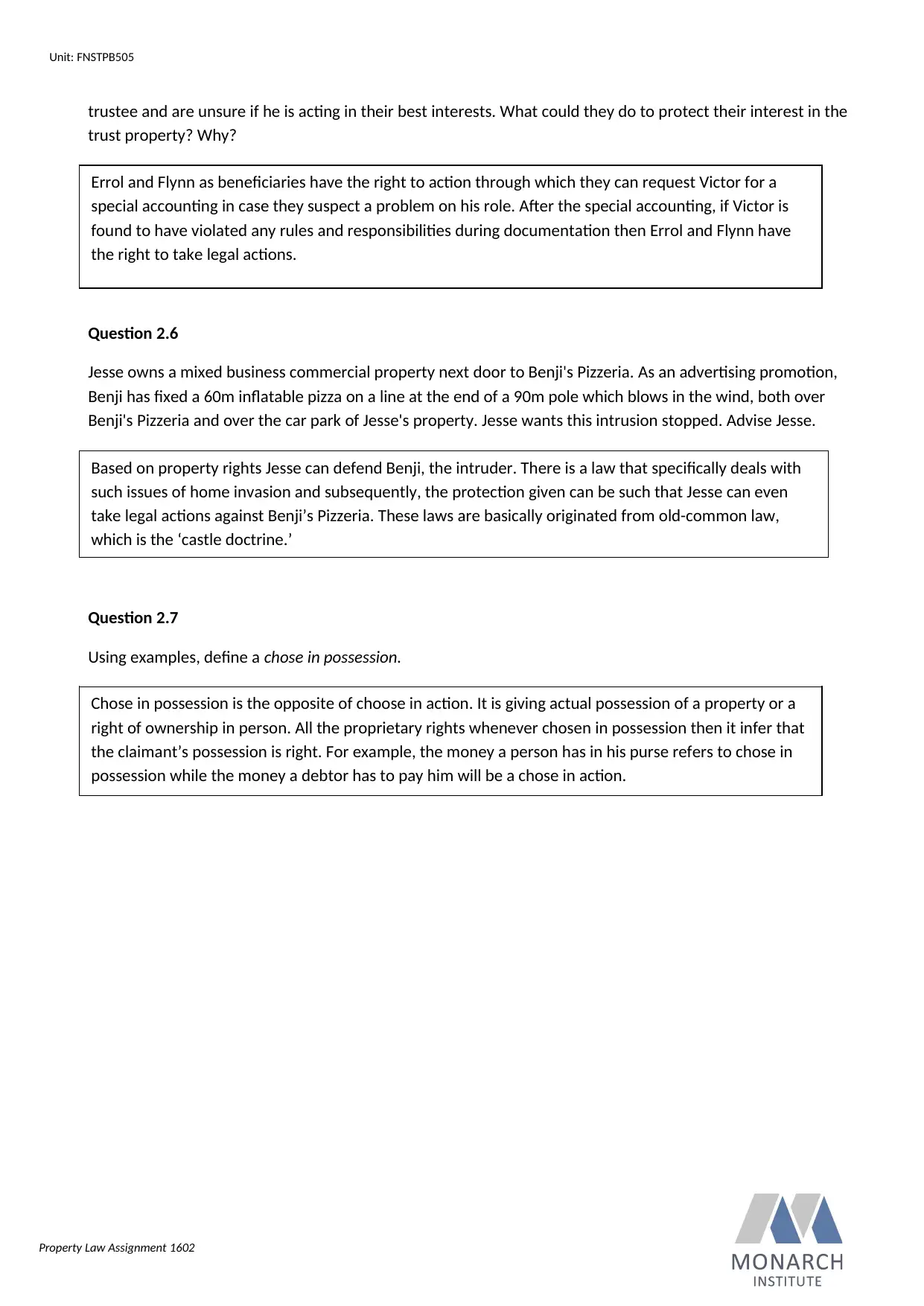
Property Law Assignment 1602
trustee and are unsure if he is acting in their best interests. What could they do to protect their interest in the
trust property? Why?
Question 2.6
Jesse owns a mixed business commercial property next door to Benji's Pizzeria. As an advertising promotion,
Benji has fixed a 60m inflatable pizza on a line at the end of a 90m pole which blows in the wind, both over
Benji's Pizzeria and over the car park of Jesse's property. Jesse wants this intrusion stopped. Advise Jesse.
Question 2.7
Using examples, define a chose in possession.
Unit: FNSTPB505
Errol and Flynn as beneficiaries have the right to action through which they can request Victor for a
special accounting in case they suspect a problem on his role. After the special accounting, if Victor is
found to have violated any rules and responsibilities during documentation then Errol and Flynn have
the right to take legal actions.
Based on property rights Jesse can defend Benji, the intruder. There is a law that specifically deals with
such issues of home invasion and subsequently, the protection given can be such that Jesse can even
take legal actions against Benji’s Pizzeria. These laws are basically originated from old-common law,
which is the ‘castle doctrine.’
Chose in possession is the opposite of choose in action. It is giving actual possession of a property or a
right of ownership in person. All the proprietary rights whenever chosen in possession then it infer that
the claimant’s possession is right. For example, the money a person has in his purse refers to chose in
possession while the money a debtor has to pay him will be a chose in action.
trustee and are unsure if he is acting in their best interests. What could they do to protect their interest in the
trust property? Why?
Question 2.6
Jesse owns a mixed business commercial property next door to Benji's Pizzeria. As an advertising promotion,
Benji has fixed a 60m inflatable pizza on a line at the end of a 90m pole which blows in the wind, both over
Benji's Pizzeria and over the car park of Jesse's property. Jesse wants this intrusion stopped. Advise Jesse.
Question 2.7
Using examples, define a chose in possession.
Unit: FNSTPB505
Errol and Flynn as beneficiaries have the right to action through which they can request Victor for a
special accounting in case they suspect a problem on his role. After the special accounting, if Victor is
found to have violated any rules and responsibilities during documentation then Errol and Flynn have
the right to take legal actions.
Based on property rights Jesse can defend Benji, the intruder. There is a law that specifically deals with
such issues of home invasion and subsequently, the protection given can be such that Jesse can even
take legal actions against Benji’s Pizzeria. These laws are basically originated from old-common law,
which is the ‘castle doctrine.’
Chose in possession is the opposite of choose in action. It is giving actual possession of a property or a
right of ownership in person. All the proprietary rights whenever chosen in possession then it infer that
the claimant’s possession is right. For example, the money a person has in his purse refers to chose in
possession while the money a debtor has to pay him will be a chose in action.
Paraphrase This Document
Need a fresh take? Get an instant paraphrase of this document with our AI Paraphraser
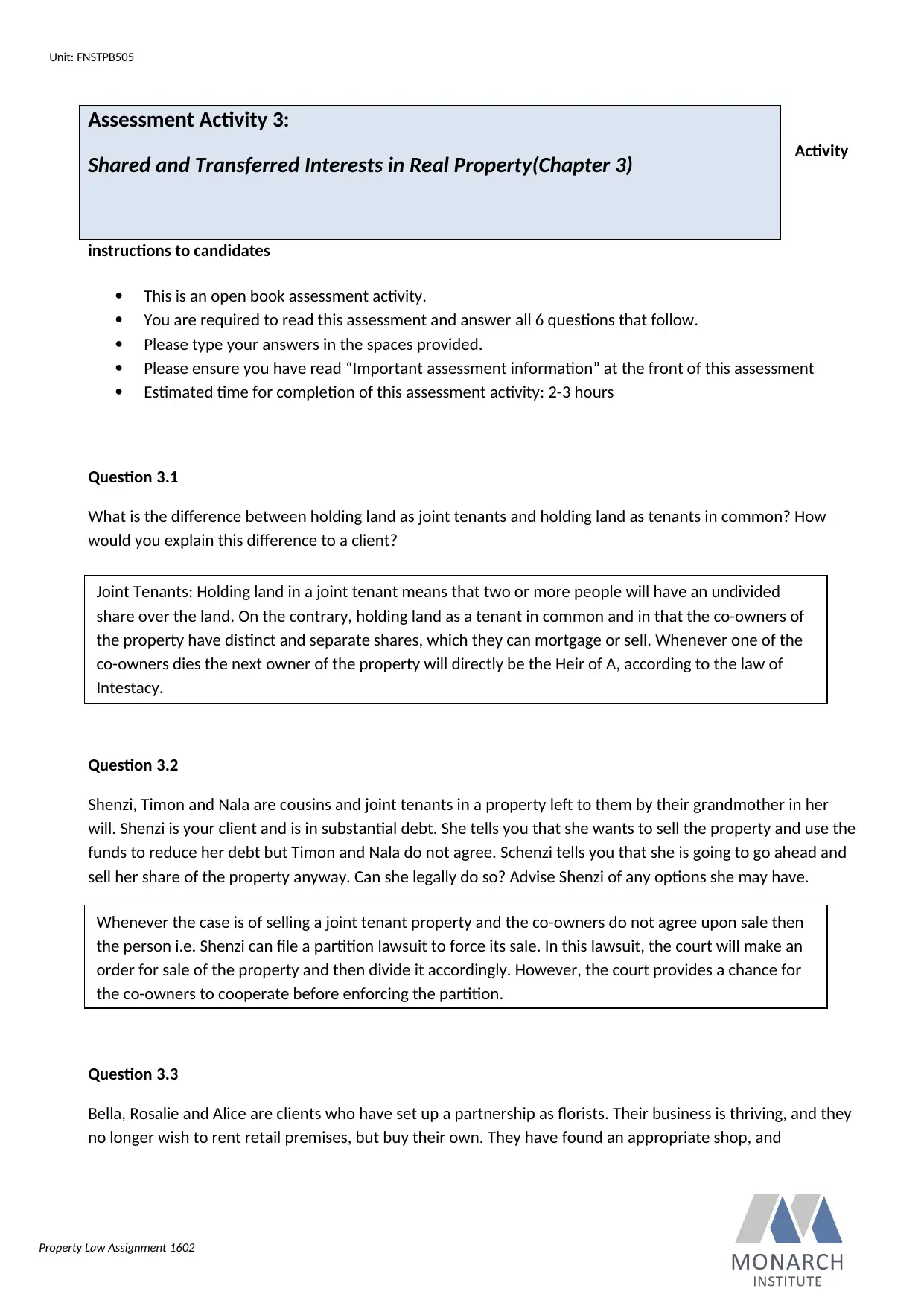
Property Law Assignment 1602
Activity
instructions to candidates
This is an open book assessment activity.
You are required to read this assessment and answer all 6 questions that follow.
Please type your answers in the spaces provided.
Please ensure you have read “Important assessment information” at the front of this assessment
Estimated time for completion of this assessment activity: 2-3 hours
Question 3.1
What is the difference between holding land as joint tenants and holding land as tenants in common? How
would you explain this difference to a client?
Question 3.2
Shenzi, Timon and Nala are cousins and joint tenants in a property left to them by their grandmother in her
will. Shenzi is your client and is in substantial debt. She tells you that she wants to sell the property and use the
funds to reduce her debt but Timon and Nala do not agree. Schenzi tells you that she is going to go ahead and
sell her share of the property anyway. Can she legally do so? Advise Shenzi of any options she may have.
Question 3.3
Bella, Rosalie and Alice are clients who have set up a partnership as florists. Their business is thriving, and they
no longer wish to rent retail premises, but buy their own. They have found an appropriate shop, and
Assessment Activity 3:
Shared and Transferred Interests in Real Property(Chapter 3)
Unit: FNSTPB505
Joint Tenants: Holding land in a joint tenant means that two or more people will have an undivided
share over the land. On the contrary, holding land as a tenant in common and in that the co-owners of
the property have distinct and separate shares, which they can mortgage or sell. Whenever one of the
co-owners dies the next owner of the property will directly be the Heir of A, according to the law of
Intestacy.
Whenever the case is of selling a joint tenant property and the co-owners do not agree upon sale then
the person i.e. Shenzi can file a partition lawsuit to force its sale. In this lawsuit, the court will make an
order for sale of the property and then divide it accordingly. However, the court provides a chance for
the co-owners to cooperate before enforcing the partition.
Activity
instructions to candidates
This is an open book assessment activity.
You are required to read this assessment and answer all 6 questions that follow.
Please type your answers in the spaces provided.
Please ensure you have read “Important assessment information” at the front of this assessment
Estimated time for completion of this assessment activity: 2-3 hours
Question 3.1
What is the difference between holding land as joint tenants and holding land as tenants in common? How
would you explain this difference to a client?
Question 3.2
Shenzi, Timon and Nala are cousins and joint tenants in a property left to them by their grandmother in her
will. Shenzi is your client and is in substantial debt. She tells you that she wants to sell the property and use the
funds to reduce her debt but Timon and Nala do not agree. Schenzi tells you that she is going to go ahead and
sell her share of the property anyway. Can she legally do so? Advise Shenzi of any options she may have.
Question 3.3
Bella, Rosalie and Alice are clients who have set up a partnership as florists. Their business is thriving, and they
no longer wish to rent retail premises, but buy their own. They have found an appropriate shop, and
Assessment Activity 3:
Shared and Transferred Interests in Real Property(Chapter 3)
Unit: FNSTPB505
Joint Tenants: Holding land in a joint tenant means that two or more people will have an undivided
share over the land. On the contrary, holding land as a tenant in common and in that the co-owners of
the property have distinct and separate shares, which they can mortgage or sell. Whenever one of the
co-owners dies the next owner of the property will directly be the Heir of A, according to the law of
Intestacy.
Whenever the case is of selling a joint tenant property and the co-owners do not agree upon sale then
the person i.e. Shenzi can file a partition lawsuit to force its sale. In this lawsuit, the court will make an
order for sale of the property and then divide it accordingly. However, the court provides a chance for
the co-owners to cooperate before enforcing the partition.
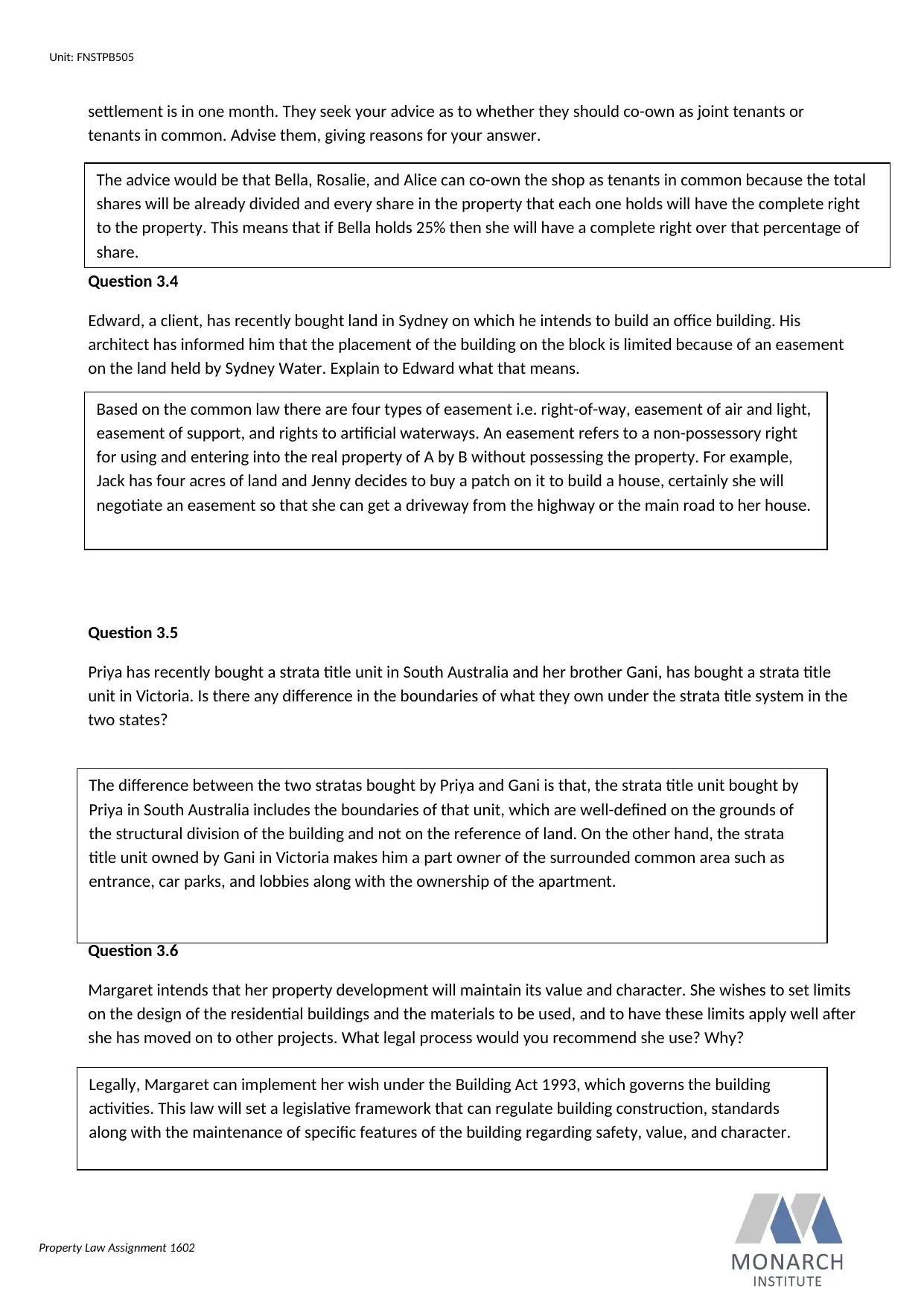
Property Law Assignment 1602
settlement is in one month. They seek your advice as to whether they should co-own as joint tenants or
tenants in common. Advise them, giving reasons for your answer.
Question 3.4
Edward, a client, has recently bought land in Sydney on which he intends to build an office building. His
architect has informed him that the placement of the building on the block is limited because of an easement
on the land held by Sydney Water. Explain to Edward what that means.
Question 3.5
Priya has recently bought a strata title unit in South Australia and her brother Gani, has bought a strata title
unit in Victoria. Is there any difference in the boundaries of what they own under the strata title system in the
two states?
Question 3.6
Margaret intends that her property development will maintain its value and character. She wishes to set limits
on the design of the residential buildings and the materials to be used, and to have these limits apply well after
she has moved on to other projects. What legal process would you recommend she use? Why?
Unit: FNSTPB505
Based on the common law there are four types of easement i.e. right-of-way, easement of air and light,
easement of support, and rights to artificial waterways. An easement refers to a non-possessory right
for using and entering into the real property of A by B without possessing the property. For example,
Jack has four acres of land and Jenny decides to buy a patch on it to build a house, certainly she will
negotiate an easement so that she can get a driveway from the highway or the main road to her house.
The difference between the two stratas bought by Priya and Gani is that, the strata title unit bought by
Priya in South Australia includes the boundaries of that unit, which are well-defined on the grounds of
the structural division of the building and not on the reference of land. On the other hand, the strata
title unit owned by Gani in Victoria makes him a part owner of the surrounded common area such as
entrance, car parks, and lobbies along with the ownership of the apartment.
The advice would be that Bella, Rosalie, and Alice can co-own the shop as tenants in common because the total
shares will be already divided and every share in the property that each one holds will have the complete right
to the property. This means that if Bella holds 25% then she will have a complete right over that percentage of
share.
Legally, Margaret can implement her wish under the Building Act 1993, which governs the building
activities. This law will set a legislative framework that can regulate building construction, standards
along with the maintenance of specific features of the building regarding safety, value, and character.
settlement is in one month. They seek your advice as to whether they should co-own as joint tenants or
tenants in common. Advise them, giving reasons for your answer.
Question 3.4
Edward, a client, has recently bought land in Sydney on which he intends to build an office building. His
architect has informed him that the placement of the building on the block is limited because of an easement
on the land held by Sydney Water. Explain to Edward what that means.
Question 3.5
Priya has recently bought a strata title unit in South Australia and her brother Gani, has bought a strata title
unit in Victoria. Is there any difference in the boundaries of what they own under the strata title system in the
two states?
Question 3.6
Margaret intends that her property development will maintain its value and character. She wishes to set limits
on the design of the residential buildings and the materials to be used, and to have these limits apply well after
she has moved on to other projects. What legal process would you recommend she use? Why?
Unit: FNSTPB505
Based on the common law there are four types of easement i.e. right-of-way, easement of air and light,
easement of support, and rights to artificial waterways. An easement refers to a non-possessory right
for using and entering into the real property of A by B without possessing the property. For example,
Jack has four acres of land and Jenny decides to buy a patch on it to build a house, certainly she will
negotiate an easement so that she can get a driveway from the highway or the main road to her house.
The difference between the two stratas bought by Priya and Gani is that, the strata title unit bought by
Priya in South Australia includes the boundaries of that unit, which are well-defined on the grounds of
the structural division of the building and not on the reference of land. On the other hand, the strata
title unit owned by Gani in Victoria makes him a part owner of the surrounded common area such as
entrance, car parks, and lobbies along with the ownership of the apartment.
The advice would be that Bella, Rosalie, and Alice can co-own the shop as tenants in common because the total
shares will be already divided and every share in the property that each one holds will have the complete right
to the property. This means that if Bella holds 25% then she will have a complete right over that percentage of
share.
Legally, Margaret can implement her wish under the Building Act 1993, which governs the building
activities. This law will set a legislative framework that can regulate building construction, standards
along with the maintenance of specific features of the building regarding safety, value, and character.
⊘ This is a preview!⊘
Do you want full access?
Subscribe today to unlock all pages.

Trusted by 1+ million students worldwide
1 out of 22
Related Documents
Your All-in-One AI-Powered Toolkit for Academic Success.
+13062052269
info@desklib.com
Available 24*7 on WhatsApp / Email
![[object Object]](/_next/static/media/star-bottom.7253800d.svg)
Unlock your academic potential
Copyright © 2020–2025 A2Z Services. All Rights Reserved. Developed and managed by ZUCOL.





